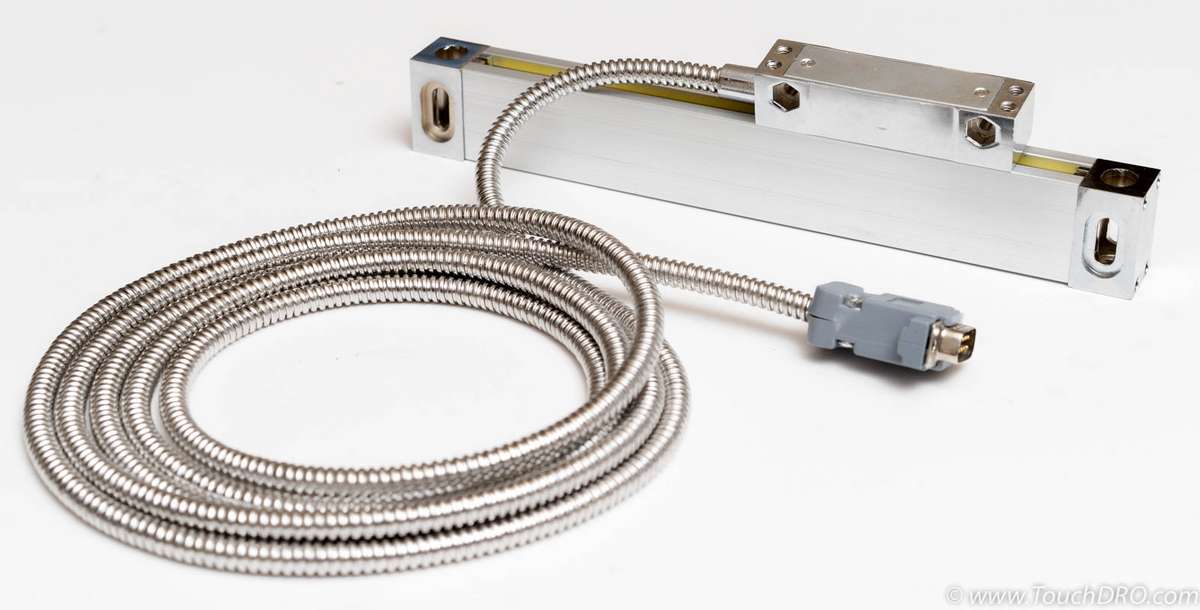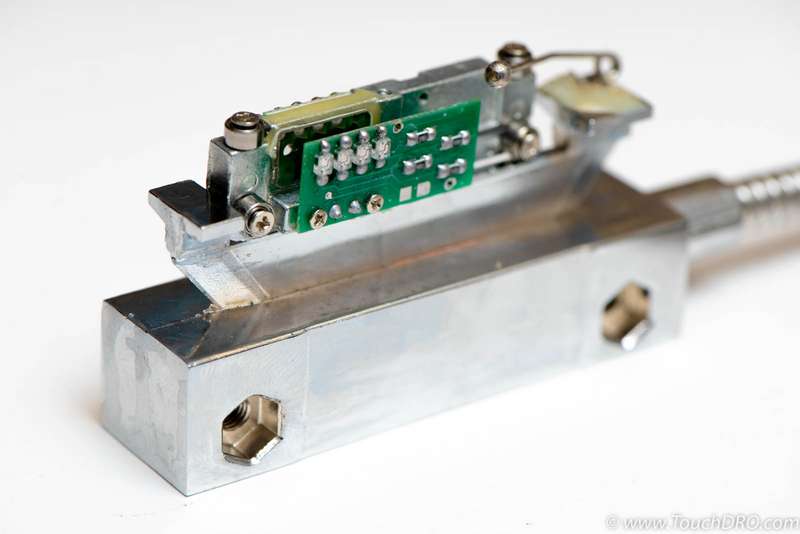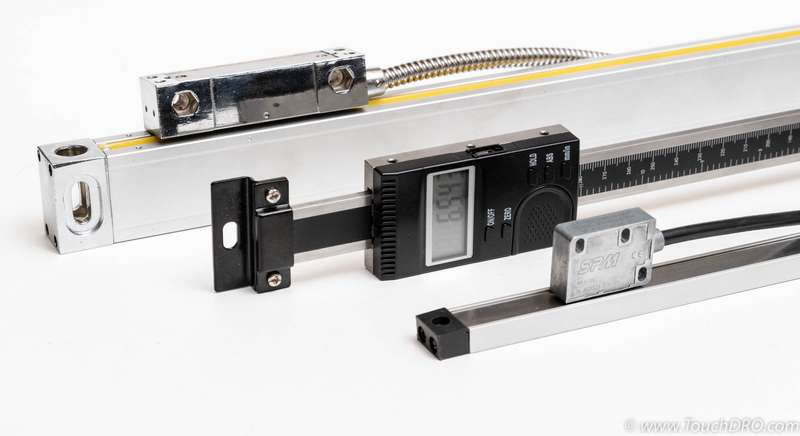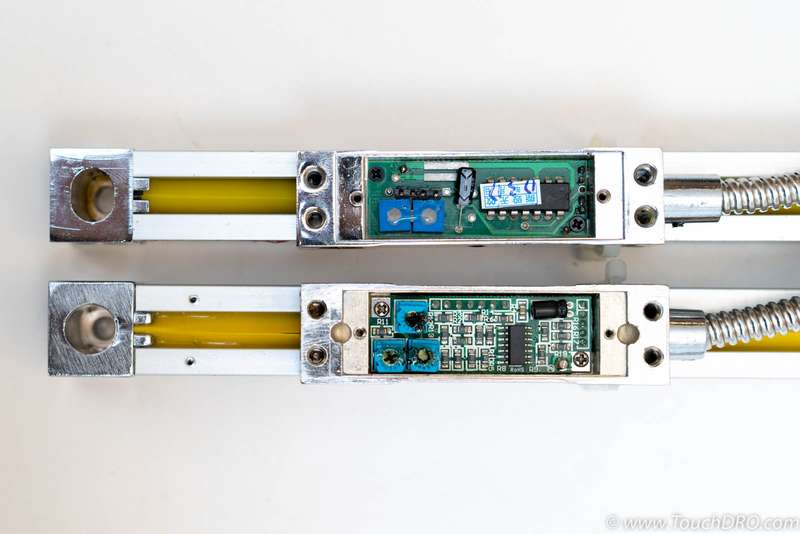Optical DRO Scales

Introduction
Glass DRO scales have been used in professional digital readouts for several decades. Until recently, Glass scales were prohibitively expensive and were relatively uncommon in hobby machine shops. Fortunately, Chinese glass DRO scales have significantly dropped in price putting them well within the reach of small shops and hobbyists.
At the moment, glass scales offer arguably the best balance of price/quality/performance. Due to the inherent stability of their glass encoder strip and the maturity of the manufacturing process, modern glass scales have excellent resolution and accuracy. Moreover, most modern glass scales have standardized on using 5V quadrature output, which makes scales from different brands easily interchangeable and easy to interface to TouchDRO system.
Glass scales are a form of a quadrature incremental optical encoder. They use a strip of a high-quality glass with evenly spaced microscopic marks etched into it and a photo-electronic reading head that moves along it. The marks are commonly spaced at 5 micron distance, but 1-micron versions are commonly available as well. The head contains a photo sensor that consists of photodiodes precisely spaced at a distance that is either 75% or 125% of the distance between marks. Scale's internal circuit conditions and amplifies the detected signal; so, the resulting output consists of two square waves that are 90 degrees out of phase. The DRO is able to detect the pulses from the scales and, by comparing the state of the two channels, interprets the direction of the movement.
Pros
Excellent Accuracy
The encoder strip used inside the scales is made of high quality glass that has very low coefficient of thermal expansion; so, the scales have excellent thermal stability. Combined with the mature process of precision photo etching, glass scales are inherently very accurate.
Superior Noise Resistance
Glass scales have the best electromagnetic interference resistance of all DRO scale types. This is due to the fact that they use photo sensors that are almost fully enclosed within metallic frames with only a narrow opening and the cable enclosed in a flexible metal shroud. In other words, the electronics and wiring are enclosed in a Faraday cage that shields them from any sort of electromagnetic, capacitive and inductive coupling. Combined with 5V signal level, this results in an excellent signal-to-noise ratio.
Real-Time Signal
Glass scales use very simple signal processing and amplification circuits with no digital signal processing. Consequently, they provide a true real-time signal that results in no lag between scale movement and scale output.
Cons
Internal Backlash

In order to allow for flex and misalignment the coupling between the external reading head and the carriage that rides along the glass encoder, strip has to be somewhat flexible. Most common designs use a small piece of stiff spring wire to press the carriage against the strip. This arrangement has a small amount of inherent play that can result in backlash on the scale.
Long-Term Durability
The marks on the encoder strip and the slits in the sensor are incredibly small. If dirt or coolant gets onto the encoder strip, the scale will not function properly. Furthermore, glass scales have more moving parts than any other type of scales, including several miniature ball bearings that ride along the glass strip. Over time, those bearings will wear and can exacerbate the backlash or simply fail and damage the encoder strip.
Physical Size and Mounting Issues

Glass DRO scales are bulkier than most other scale types, come in a limited number of sizes, and can't be cut to fit machine dimension. On top of that, to avoid ingestion of dirt, they need to be mounted with the slit facing down or at least away from the cutter. As a result, they can take up a lot of space and, in some cases, restrict machine movement or limit functionality.
TouchDRO Compatibility
Virtually all Chinese glass DRO scales and majority of name-brand glass scales are compatible with TouchDRO. When purchasing a set of glass scleas for use with TouchDRO, it's important to obtain and study their pin mapping. Most reputable suppliers provide at least a basic spec sheet that includes a table or a diagram describing connector pin functions. If there are 0V, +5V, A, B, and R or Z lines, the scales are compatible. Optionally, there might be A', B', R'/Z' lines, which will be discussed later. On the other hand, if the scales has "Data", "Excitation" lines, uses negative supply voltage or supply voltage other than 5V, it is not compatible with TouchDRO.
Important Technical Parameters
In addition to the above, there are a few other important technical parameters that affect the price of the glass DRO scales.
Differential vs. Single Ended Output
Glass DRO scales can output single ended TTL signal or differential signal using RS422 standard. In the former case, the scale uses single wire per channel. In the latter case, each channel uses two wires that carry complementary signals. In other words, when A is high, A' is low. Specialized RS422 decoder IC can then invert A' signal and sum it with the A signal. Since any noise present in the wire will also be inverted, it will be cancelled out, while the signal will be summed up. As a result, RS422 scales are even more resilient to noise and can be used with very long cable runs of tens or even hundreds of feet. TouchDRO adapter supports both types, but for most shops RS422 is not needed since the length of the cables is very short and is not worth the extra price.
Resolution
Glass scales come in 1 micron and 5 micron resolution with the latter being significantly more expensive and somewhat less common. For use on a milling machine, a set of five micron scales will provide more than enough resolution. On a lathe, it's common to see a setup where a 5-micron scale is used for the Z axis and 1-micron scale is used for the cross slide to provide better resolution for diameter turning. A surface grinder will usually benefit from a set of 1-micron scales in order to reliably hold tolerances down to ten thousandths of an inch.
Quality Considerations
As is the case with many things made in China, the manufacturers build a product to customer's quality standards. Scales from the more well known Chinese brands such as Easson and Ditron are of excellent quality on par with more premium western brands. Unfortunately, many of the non-name and generic DRO scales are able to offer such a low price point by cutting some corners, using lesser quality components, and neglecting quality control.

Dirt and Coolant Protection
Glass scales are very sensitive to moisture and dirt that can enter their body. To protect against this, most glass scales have one or more layers of rubber seals running along the length of the slit. It's common for the slim models to have one set of seals, while regular sized models have two sets. Unfortunately, this is the area where some discount brands tend to cut cost, so it's important to ensure that the scale has the correct number of seals.
Sensor Alignment
The marks on the encoder and the corresponding slits in the photodetector are incredibly small and for optimal performance need to be precisely aligned. If they are not perfectly parallel, the signal quality will be degraded and the scale will not perform optimally. Most scales have a way to adjust the alignment, usually via a small screw in the carriage. Since the alignment process takes extra time, this is the area where the manufacturers can cut corners.
Non-Linear Error
Generally speaking, the encoder strips used in Chinese glass scales are very accurate and have little-to-none non linear error. Unfortunately, some online vendors intentionally use components that failed quality assurance to hit a low price point. As a result, it's possible to come across DRO scales with non-uniform ethiching or missing marks, which will introduce random errors throughout the length of the scale that are very difficult to detect without specialized calibration equipment.
Another component that can introduce position error are the miniature bearings that ride on the glass strip. Low quality bearings can introduce microscopic amounts of wobble into the carriage which can introduce cyclic error into the scale output.
Assembly Issues
Final area that can affect performance and reliability of the scales is electronic and mechanical assembly. In most cases, the cables are soldered manually to the PCB inside the scales and to the connector pins. Cold solder joints or frayed wires can create intermittent issues during operation that can wreak havoc with the DRO. Furthermore, since the carriage is subject to constraint vibration, the screws can come loose if no thread locking compound is used.
Bottom Line
Glass DRO scales offer a good balance of price, quality and performance and are in almost every way superior to the capacitive scales. They do have a few drawbacks such as sensitivity to dirt and moisture, internal backlash, and potential size issues. Despite those issues, glass scales completely dominate the DRO market thanks to their inherent stability, excellent accuracy and outstanding noise resistance.
